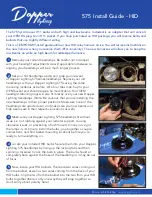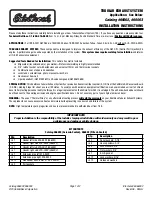
Displaying Tire Pressures
You can display tire pressures on the instrument panel
by using the right or left steering wheel buttons to
display
Car Status
or
). You can also choose whether you
want to display tire pressures using Bar or PSI by
touching
Controls
>
Display
>
Tire Pressure
.
Maintaining Tire Pressures
Keep tires inflated to the pressures shown on the Tire
and Loading Information label, even if it differs from the
pressure printed on the tire itself. The Tire and Loading
Information label is located on the center door pillar and
is visible when the front door is open.
If you are towing a trailer, do not use the tire pressures
printed on the Tire and Loading Information Label.
Instead, refer to the tire pressures published in the
towing section (see
Towing and Accessories on page
).
The Tire Pressure indicator light on the
instrument panel alerts you if one or more
tires is under- or over-inflated.
The Tire Pressure indicator light does not immediately
turn off when you adjust tire pressure. After inflating the
tire to the recommended pressure, you must drive over
25 km/h for a short amount of time to activate the Tire
Pressure Monitoring System (TPMS), which turns off the
Tire Pressure indicator light.
If the indicator light flashes for one minute whenever
you power on Model X, a fault with the TPMS is detected
(see
NOTE:
Your vehicle’s tire pressures will drop in cold
ambient temperatures. If the TPMS indicator light
appears, inflate the tires before driving. The tires will
lose one PSI for every 6° C drop in outside temperature.
Proper tire pressures help protect tires from potholes
and improve range when properly inflated.
WARNING:
Under-inflation is the most common
cause of tire failures and can cause a tire to
overheat, resulting in severe tire cracking, tread
separation, or blowout, resulting in unexpected
loss of vehicle control and increased risk of injury.
Under-inflation also reduces the vehicle's range
and tire tread life.
WARNING:
Check tire pressures using an accurate
pressure gauge when tires are cold. It takes only
about 1.6 kms of driving to warm up the tires
sufficiently to affect tire pressures. Parking the
vehicle in direct sunlight or in hot weather can also
affect tire pressures. If you must check warm tires,
expect increased pressures. Do not let air out of
warm tires in an attempt to match recommended
cold tire pressures. A hot tire at or below the
recommended cold tire inflation pressure is
dangerously under-inflated.
Checking and Adjusting Tire Pressures
Follow these steps when tires are cold and Model X has
been stationary for over three hours:
1. Refer to the Tire and Loading Information label
located on the driver’s center door pillar for the
target tire pressure.
2. Remove the valve cap.
3. Firmly press an accurate tire pressure gauge onto the
valve to measure pressure.
4. If required, add or remove air to reach the
recommended pressure.
NOTE:
You can release air by pressing the metal stem
in the center of the valve.
5. Re-check pressure using the accurate tire gauge.
6. Repeat steps 3 and 4 as necessary until the tire
pressure is correct.
7. Reinstall the valve cap to prevent dirt from entering.
Periodically check the valve for damage and leaks.
Inspecting and Maintaining Tires
Regularly inspect the tread and side walls for any sign of
distortion (bulges), foreign objects, cuts or wear.
Tire Care and Maintenance
191
Maintenance
Содержание MODEL X 2015
Страница 1: ...MODEL X 2015 2020 OWNER S MANUAL Software version 2022 12 New Zealand...
Страница 51: ...Child Safety Seats 49 Seating and Safety Restraints...
Страница 62: ...Steering Wheel 60 MODEL X Owner s Manual...
Страница 276: ...Publication date 2022 4 14...
















































